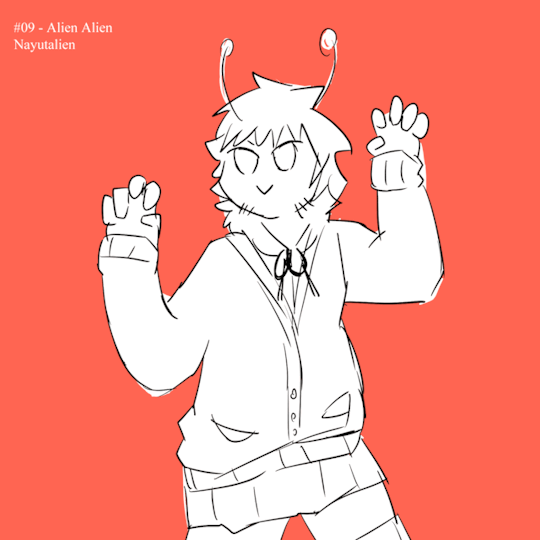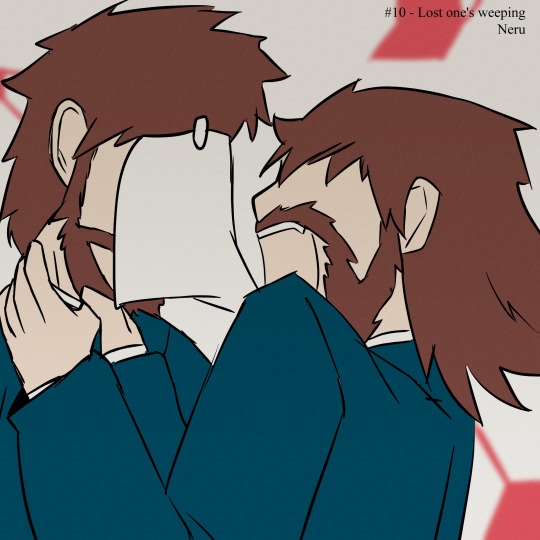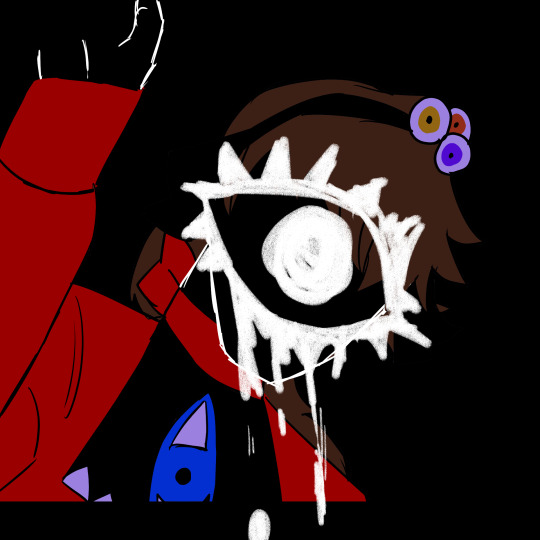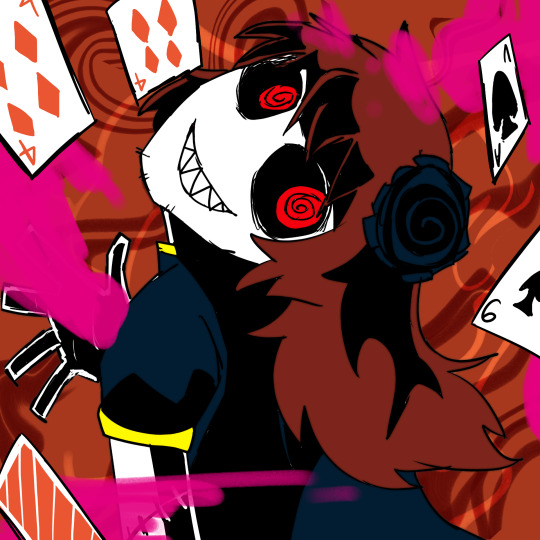#pathological facade icons
Text






Anonymous asked: "Could I please request some non binary pride icons in style 7 from the pathological facade mv by Ghost?"
Style 7 nonbinary Pathological Facade icons for anon! LMK if you'd like any changes!
Free to use; reblogs appreciated!
#kasane teto#kasane teto icons#teto kasane icons#nonbinary icons#pride icons#pathological facade#pathological facade icons#ghost#teto#teto icons#utau#utau icons#non binary icons#nb icons#icons#icon edits#pride#utauloid#utauloid icons#requested
180 notes
·
View notes
Text




























Drew 28 vocasynth self portrait icons for a twitter countdown to my birthday Dec. 28th!
In order - Pamela, Otome Dissection, Dramaturgy, Pathological Facade, Lagtrain, Living Millenium, Yobanashi Deceive, Song of the Night, Alien Alien, Lost one's weeping, Neroism, Common World Domination, PSY, Jackpot Sad Girl, I Don't Wanna Know, Bitter Choco Decoration, Nonbreath Oblige, Lower One's Eyes, Traffic Jam, I'll Stick My Tongue Out At You, Liar Dancer, Nonsense Literature, I'm Glad You're Evil Too, Additional Memory, Jitterbug, Death Should Not Have Taken Thee, Ameri, Matryoshka
#Vocasynth#vocaloid redraw#digital art#csp#Jin#NILFRUITS#Hachi#Jesus-P#pinocchiop#Nuyuri#Nanashi Hachiya#kagerou project#kagepro#Ghost and pals#inabakumori#Deco*27#Iyowa#R-906#sedo sounder#syudou#Hifumi#balloon#Eve#Kairiki bear#nayutalien
44 notes
·
View notes
Text
taking a break from the picrew icons for pathological facade teto. as a treat
0 notes
Text
✩ Interview with a Mun ✩

➊ How many ships do you have on this blog?
(( For now I have three confirmed romantic ships on this blog: Crowley & Aziraphale ( @omniishambles ), Dean & Castiel ( @awaywardboy-andhisangel ), Sara & Ava ( @xstabcastx ). I’ve other partners who are open to ship with me, but it’s still a work in progress! ))
➋ Have you ever roleplayed with someone that just left an unforgettable impression on you?
(( On this blog (and counting also the two RP I put together to create the first version of this one), yeah, I had the luck of running into a few great RP partners. With three of them I’m still interacting, which is a blessing for how I see it (which would be @paradiseturnedhell {even if we mostly write on my sideblog for the moment}, @omniishambles and @awaywardboy-andhisangel ). There have been another couple of people, but I lost contact with them a long time ago. ))
➌ Which of your ships on this blog is the fluffiest?
(( Crowley and Aziraphale without doubt. It’s just in their nature to be, even if, of course, there are other shades to their relationship xD ))
➍ Would you say you’re a decent roleplayer or do you have any self doubts?
(( Technically speaking, both. I know that I’m a decent writer generally speaking, which however doesn’t automatically mean that I’m a good RPer. ))
(( I doubt my writing quite often, but never as much as I doubt my ability of being a decent RP partner. It’s harder at times to write RPs, because you need to get in sync with the person you’re writing against and, if said person has a specific style / way to RP that’s different from mine and wants to stick to that, it can become a real struggle for me to conform to it. At times I really have the feeling that I’m failing at it, so...that definite fuels my doubts a lot. ))
➎ Have you made lots of friends on this blog?
(( Not a lot, also because I’m not much of a people person and I tend to have few friends in general, but I made a few. Not counting the ones I interact with on my sideblog, I’d say 4. ))
➏ What’s the one thing you especially love about roleplaying your muse(s)?
(( I guess I have to list one per each muse xD ))
Crowley: I love writing his inner contrasts. The need to put on a certain facade and pretend to fit into a certain crowd, while he is nothing like them. And the need to know and understand and care on one side versus the fear of the consequences.
Dean: He has this dual struggled inside himself too, but unlike Crowley, Dean wants to fit in the mental image he has been forced to build for himself. And that comes clashing with his more sensible sides, not to mention all the trauma he has to bottle up because that’s how it should be done.
Five: I live that he’s a very complex character, but what I enjoy the most is writing his sharp edges. Sarcasm, cynicism, violence. I never forget where they are sprouted from, because I don’t want to reduce him to that, but it doesn’t make them less fun to write.
Gabriel: He’s a bit like Five, tbh. I love to write his malicious trickster persona, but I must say that what really wins me over is his extremely complex relationship with his family and with whom he used to be. It’s hard to try and put the pieces together after such a long time. Some have been lost, some have changed their shape. Plenty of possible scenarios.
Michael: My fave thing about writing Michael is that I get to write three characters in one (even if, of course, they still have their fundamental traits in common, because they are the same character): pre-Fall Michael (who is more malleable, more prone to emotion, even if he’s still a strict teacher and commander); post-Fall Michael (who has reduced himself to what he thinks being his mission, isolating himself from everyone else for millennia till the End comes); post-Cage Michael (I follow my own HCs for that, who is someone who has lost everything, including a purpose, and has to struggle to find his place in a world that’s suddenly foreign to him);
Sara: What I love about her is that she isn’t just someone who has survived the hardships life has put her through, but she has always become a better and stronger person because of her trauma. And now she is there for others and still willing to go through hell and back for the sake of what she thinks it’s right. She is an inspiration to me in that sense too.
➐ Are there any people you’ve been to afraid of approaching?
(( No one specifically, ‘cause I’m just pathologically bad at approaching new people in general. I find it very hard to make the first move, so I usually wait for the other person to come to me, which most of the times doesn’t happen. I’m trying to work on strategies to overcome the issue, but...I’m still bad at it. ))
➑ Give us a rough estimate: How much time have you spent on your graphics? (icons, theme, banners, promos, etc)
(( Too much considering the poor results. I try not to waste too much time on graphics. I mess around a bit, but once I find something that works and looks half-decent, I tend to stick to it. I’m the kind of RPer that prefers practicability over fanciness. I’m here to write, not to make graphics. If I had to give a rough estimation...I’d say 3-4 hours? ))
➒ Got any memorable threads on here? Care to mention a few?
(( This blog is relatively new and considering that it’s also slow activity, I haven’t gone super far with my threads yet. I can mention a couple of threads I had when I still had my muses on separate sideblogs, tho! In no particular order: ))
A small and sweet thread for New Year’s Eve (2019) I had with @awaywardboy-andhisangel
A still ongoing thread I started on my Crowley’s sideblog with @omniishambles and that’s basically an extension of the Bus Scene in the show (with the two dorks being dorks)
An AU I had built with @paradiseturnedhell back when she wrote Crowley too (yep, two Crowleys)
The concept of an AU I had come up with and started with @gaily-gavotte
(( Aisde from these, I currently have quite a few threads I’m really excited about and that looks absolutely great. I have no doubt that they’ll end up in the list of the memorable ones! ))
➓ What were some of the most frustrating moments you had with your muse(s)’ interaction with another muse?
(( I have a couple of examples in mind, even if there’s surely been more. ))
(( One was when I was writing with this one person and they focused completely on their character in their replies, to the point that I had the impression that they didn’t even read my answers, or barely skimmed through them. I had to be the one to make the thread flow and I found myself having to write a particular point in three different replies in a role before it was acknowledged. I’m not writing with that person anymore, because I have little free time and I really don’t want to waste it on people who don’t care about my side of the thread, but it still irks me thinking back about it. ))
(( The other thing is starting a thread, even after having plotted a bit, and having the other person continuously dropping it without a warning. I put muse and effort in all my replies and seeing them disappearing into the void every single time eventually got on my nerves. Especially since the other person kept coming to ask me for more interactions and I think we both knew that they would have ended up dropping them after a few replies. Again, that’s not the sort of thing I like to use my little free time for. ))
[meme template]
#(( mun scotty's personal log ::ooc:: ))#(( about the mun ))#long post#long post cw#(( munday ))#(( beam me up scotty ::queue:: ))
6 notes
·
View notes
Text
Examples of Psychological Abuse
Ridicule or insult you then tell you it’s a joke, or that you have no sense of humor.
Put down your beliefs, religion, race, heritage - or that of your family / friends.
Withhold approval, appreciation or affection.
Give you the silent treatment.
Ignore direct questions…Walk away without answering.
Criticize you, call you names, yell at you.
Humiliate you privately or in public.
Roll his or her eyes … or mimic you when you talk.
Disrespect or insult you, then tell you that you’re too sensitive.
Seem energized by arguing, while arguing exhausts you.
Have unpredictable mood swings, alternating between good and bad for no apparent reason.
“Twist” your words, somehow turning whatever you say against you.
Complain about how badly you treat him or her.
Threaten to leave, or threaten to throw you out.
Say things that make you feel good, but do things that make you feel bad.
Compliment you enough to keep you happy, yet criticize you enough to keep you insecure.
Harass you about imagined affairs.
Manipulate you with lies and contradictions.
Act immature and selfish, yet accuse you of those behaviors.
Question your every move and motive, somehow questioning your competence.
Constantly interrupt you while you’re trying to make your point.
Make you feel like you can never win : damned if you do, damned if you don’t.
Incite you to rage, which is “proof” that you are the one with the “problem” - not them.
Try to convince you that they are “right,” while you are “wrong”.
Frequently say things that are later denied or accuse you of misunderstanding.
Additionally:
Alienation - The act of cutting off or interfering with an individual's relationships with others.Baiting - A provocative act used to solicit an angry, aggressive or emotional response from another individual.Belittling, Condescending and
Patronizing - This kind of speech is a passive-aggressive approach to giving someone a verbal put-down while maintaining a facade of reasonableness or friendliness.
Blaming - The practice of identifying a person or people responsible for creating a problem, rather than identifying ways of dealing with the problem.
Bullying - Any systematic action of hurting a person from a position of relative physical, social, economic or emotional strength.
Bunny Boiling - Bunny Boiling is a reference to an iconic scene in the movie "Fatal Attraction" in which the main character Alex, who suffers from Borderline Personality
Disorder, kills the family's pet rabbit and boils it on the stove. Bunny Boiling has become a popular reference to how people sometimes exhibit their rage by behaving destructively towards symbolic, important or treasured possessions or representations of those whom they wish to hurt, control or intimidate.
Cheating - Sharing a romantic or intimate relationship with somebody when you are already committed to a monogamous relationship with someone else.
Compulsive Lying - Compulsive Lying is a term used to describe lying frequently out of habit, without much regard for the consequences to others and without having an obvious motive to lie. A compulsive liar is someone who habitually lies.
Cruelty to Animals - Acts of Cruelty to Animals have been statistically discovered to occur more often in people who suffer from personality disorders than in the general population.
Dependency - An inappropriate and chronic reliance by an adult individual on another individual for their health, subsistence, decision making or personal and emotional well-being.
Emotional Blackmail - A system of threats and punishments used in an attempt to control someone’s behaviors.
Engulfment - An unhealthy and overwhelming level of attention and dependency on another person, which comes from imagining or believing one exists only within the context of that relationship.
False Accusations - Patterns of unwarranted or exaggerated criticism directed towards someone else.
Favoritism - Favoritism is the practice of systematically giving positive, preferential treatment to one child, subordinate or associate among a family or group of peers.
FOG - Fear, Obligation & Guilt - The acronym FOG, for Fear, Obligation and Guilt, was first coined by Susan Forward & Donna Frazier in Emotional Blackmail and describes feelings that a person often has when in a relationship with someone who suffers from a personality disorder.
Gaslighting - The practice of brainwashing or convincing a mentally healthy individual that they are going insane or that their understanding of reality is mistaken or false. The term “Gaslighting” is based on the 1944 MGM movie “Gaslight”.
Harassment - Any sustained or chronic pattern of unwelcome behavior by one individual towards another.
Hoovers & Hoovering - A Hoover is a metaphor taken from the popular brand of vacuum cleaners, to describe how an abuse victim trying to assert their own rights by leaving or limiting contact in a dysfunctional relationship, gets “sucked back in” when the perpetrator temporarily exhibits improved or desirable behavior.
Hysteria - An inappropriate over-reaction to bad news or disappointments, which diverts attention away from the real problem and towards the person who is having the reaction.
Imposed Isolation - When abuse results in a person becoming isolated from their support network, including friends and family.
Infantilization - Treating a child as if they are much younger than their actual age.
Intimidation - Any form of veiled, hidden, indirect or non-verbal threat.Invalidation - The creation or promotion of an environment which encourages an individual to believe that their thoughts, beliefs, values or physical presence are inferior, flawed, problematic or worthless.
Mirroring - Imitating or copying another person's characteristics, behaviors or traits.
Name-Calling - Use of profane, derogatory or dehumanizing terminology to describe another individual or group.
No-Win Scenarios - When you are manipulated into choosing between two bad options
Objectification - The practice of treating a person or a group of people like an object.
Pathological Lying - Persistent deception by an individual to serve their own interests and needs with little or no regard to the needs and concerns of others. A pathological liar is a person who habitually lies to serve their own needs.
Perfectionism - The maladaptive practice of holding oneself or others to an unrealistic, unattainable or unsustainable standard of organization, order, or accomplishment in one particular area of living, while sometimes neglecting common standards of organization, order or accomplishment in other areas of living.
Projection - The act of attributing one's own feelings or traits to another person and imagining or believing that the other person has those same feelings or traits.
Proxy Recruitment - A way of controlling or abusing another person by manipulating other people into unwittingly backing “doing the dirty work”
Push-Pull - A chronic pattern of sabotaging and re-establishing closeness in a relationship without appropriate cause or reason.
Ranking and Comparing - Drawing unnecessary and inappropriate comparisons between individuals or groups.
Raging, Violence and Impulsive Aggression - Explosive verbal, physical or emotional elevations of a dispute. Rages threaten the security or safety of another individual and violate their personal boundaries.
Sabotage - The spontaneous disruption of calm or status quo in order to serve a personal interest, provoke a conflict or draw attention.
Scapegoating - Singling out one child, employee or member of a group of peers for unmerited negative treatment or blame.
Self-Harm - Any form of deliberate, premeditated injury, such as cutting, poisoning or overdosing, inflicted on oneself.
Shaming - The difference between blaming and shaming is that in blaming someone tells you that youdid something bad, in shaming someone tells you that you are something bad.
Silent Treatment - A passive-aggressive form of emotional abuse in which displeasure, disapproval and contempt is exhibited through nonverbal gestures while maintaining verbal silence.
Sleep Deprivation - The practice of routinely interrupting, impeding or restricting another person's sleep cycle.
Splitting - The practice of regarding people and situations as either completely "good" or completely "bad".
Stalking - Any pervasive and unwelcome pattern of pursuing contact with another individual.
Targeted Humor, Mocking and Sarcasm - Any sustained pattern of joking, sarcasm or mockery which is designed to reduce another individual’s reputation in their own eyes or in the eyes of others.
Testing - Repeatedly forcing another individual to demonstrate or prove their love or commitment to a relationship.
Thought Policing - Any process of trying to question, control, or unduly influence another person's thoughts or feelings.
Threats - Inappropriate, intentional warnings of destructive actions or consequences.
20 notes
·
View notes
Text
Budget Travel | 4 Hotels Under Rs5,000 in Morocco
A round-up of Moroccan hotels rich in both history and character, and oozing old-world charm, which fit tight budgets.
Hotels Morocco
Zac O’Yeah | POSTED ON: September 17, 2019
The classic among Moroccan hotels, Tangier’s Continental is a sight in itself with hallways and corridors that make one feel like Alice in Wonderland. Photo by: Zac O’Yeah
I wonder if there’s a name for my peculiar psychiatric condition—a pathological love for old hotels that aren’t part of impersonal global chains, but remain strictly local, personal, and rare. Actually, it’s not a bad condition to have, it just takes a bit more effort to track down the perfect hotel, but once I find it, I can usually be sure that I’m getting an unforgettable once-in-a-lifetime holiday. Some countries have a better stock of such forgotten gems and recently, as I toured Morocco, I found myself in heaven.
Tangier
Walking with the icons
At sunrise, the Hotel Continental looks golden, like a ruminating camel perched lazily on a cliff overlooking the Bay of Tangier. I’d heard from people in the know about the late 19th-century, 70-room hotel, and found the bargain rate of 400 dirham/Rs2,900 online, and seeing its palatial grandeur in reality instantly makes travelling all the way to North Africa seem worth it.
According to a sign, the hotel was built in 1870, and prides itself on being a “hotel musée”—which I understand to mean hotel museum though my Moroccan is not so good—and it certainly looks the part. Despite the stained-glass windows that let in colourful morning light, the lobby is gloomier than the Dark Ages and filled with things one would expect in a museum: an antique telephone switchboard, a bulky radio cabinet, a battered samovar, a concierge who never smiles. It extends into a spooky antiques shop with a creepy proprietor. There are smoking rooms with upholstered benches and faux oriental embroidered cushions, and a forlorn dining hall with crystal chandeliers, dark-wood sideboards and heavy drapes, where nobody ever seems to be eating. It’s like something out of an exotic period movie—and was in fact the setting for Bernardo Bertolucci’sThe Sheltering Sky (1990), starring John Malkovich and Debra Winger as depraved American tourists.
I’m led up labyrinthine corridors to a bright, second-floor room that’s quite the opposite of the rest: thoroughly modern and, on the plus side, overlooking the sandy Tangier beach and the Strait of Gibraltar. Apparently Edgar Degas used to paint the vista from one of these rooms. Back in the day, the hotel was a mandatory stopover for anyone who was anyone visiting Africa—kings and queens; two of my favourite writers, Mark Twain (“Tangier is a foreign land if ever there was one, and the true spirit of it can never be found in any book save The Arabian Nights,” he wrote in The Innocents Abroad), and W. Somerset Maugham; singer Amy Winehouse; and architect AntoniGaudí. I wish we could have all checked into the same room at the same time. What a party!
The historic quarters with their cafés (such as Cafe Colon in Rue de la Kasbah, which due to its 1940s ambience features prominently in Bertolucci’s film) are around the corner, and Tangier’s enigmatic relationship to time becomes clear as I GPS my way through the maze to Rue IbnBatouta, where the celebrated globetrotter and original travel writer was born in 1304, and where he is buried too. After a few days of blissing out on Tangier, it feels like a major tragedy that I haven’t booked a longer stay.
Where 36, Rue Dar el-Baroud; www.hotel-tanger.com; doubles from Rs2,900.
Foodie Facts Restorante al Andalus, a seven-minute walk from the hotel in an alley off Petit Socco, is a family-owned eatery founded ages ago by Italian expatriates. It has a reputation for serving the town’s best seafood, and I sample an excellent grilled swordfish with finger chips and shish kebab (100 dirham/Rs730).
Larache
A slice of local life from a breezy balcony
Grand Hotel España remains one of the finest relics of old Spanish colonial grandeur on the African continent and the well-kept rooms are a steal considering the fabulous location right in the centre of Larache. Photo by: Zac O’Yeah
From behind the Tangier bus station, the gareroutière, I catch a shared grand taxi as they’re called: ramshackle Mercedes vehicles that provide convenient, cheap travel from city to city (about 20 dirham/Rs145 per trip). My taxi is crammed and I’m flattened like a roti in a chapati-press, but luckily it’s not far to Larache.
Larache, a Spanish colony till 1956, is the most distinctive remnant of Spain in this part of Africa. I check into the 1930s vintage Grand Hotel España, where an airy, top-floor room costs 600 dirham/Rs4,400 and has balconies on two sides—the front one overlooking a roundabout with palms and a fountain. At night, I spy families taking in the cool air and children playing until late, while people watch football and cheer in the lively cafés; it’s a perfect perch for a voyeur.
The breakfast in the cute dining hall is sumptuous. A merry waiter covers my table with a petit déjeuner that includes Moroccan flatbread, a spicy omelette, grilled cheese sandwiches, sausage, olives, fruit salad, juice, and excellent Moroccan milky coffee.
A charming thing about Larache is that there are few other tourists, so no “tourist prices” and all that. I stroll about the neat, blue-painted alleys to a flea market and browse: everything is for sale, from vacuum-cleaners and spring mattresses to straw hats, guitar amplifiers and tagine cooking pots. Afterwards, I chill with a soda pop in Café Jean Genet, which is named after the French author-slash-jailbird immortalised in David Bowie’s “The Jean Genie,” who lies buried in the Spanish cemetery outside town. It is appropriately a favourite haunt of young hashish smokers.
Where 6 Avenue Hassan II, Plaza de España; phone +212 5399-13195; doubles from Rs4,400.
Foodie Facts Larache being a pleasant fishing harbour, there’s a superb seafood canteen, Puerta del Sol, with tables set in an alley right behind my hotel. A mixed platter with the odds and ends of the ocean—squid, prawns, a tuna steak, fried flatfish, deep-fried cuttlefish and a small shark complete with teeth and eyes—served with sides of meaty lamb sausages, finger chips, seafood paella, olives and a tasty bean stew, costs 130 dirham/Rs950.
Casablanca
A window into Morocco’s French quarters
Tangier’s Continental straddles a promontory on the edge of the city’s old medina and has grand views across the sea to Spain and Gibraltar. Photo by: Zac O’Yeah
In Casablanca, the thing to do is to stay in the art deco quarters built by the French around a hundred years ago, which remain remarkably well-preserved. I’ve tracked down Hôtel Guynemer as its facade is mentioned as one of the sights in town, and booked a 450 dirham/Rs3,350 room via email. It seems like a good deal.
Guynemer opened its doors in 1909, and the lobby doesn’t show signs of having been renovated ever since art deco went out of fashion. The concierge tells me rooms are 650 dirham.
“But in the email you wrote 450.”
“We have no such rooms. There is a room for 360 but it is dirty.” It sounds like a typical tourist scam.
Checking the rooms, it turns out the more expensive one is completely modern and unappealing. The cheap room oozes charm, but is shabby, and the bathroom bulb is broken so it’s impossible to see where to pee. I ask the concierge if he has another cheapie. He grumpily gives me a key to what turns out to be a neat chamber with a high ceiling, kitschy art and the largest bathroom I’ve seen in Morocco—as big as the room itself.
And I have the heart of the city right outside my doorstep. Here, French architects were given free reign and so they tried to create a paradisiacal version of France: a neo-Moorish dream fantasy of wide, endless palm-lined boulevards dotted with charming small eateries, sidewalk cafés and smoke-filled bars.
Where 2, Rue Mohammed Belloul; guynemerhotel.net; doubles from Rs3,350.
Foodie Facts Trotting past the slightly dilapidated Marché Centrale, I contemplate hitting the fishmongers’ hall to gobble up basketfuls of fresh oysters, but decide to instead save my appetite for Taverne du Dauphin, the well-known 1958 seafood bar (115, Boulevard Felix Houphouet). It turns out to be the type of quiet joint one can easily love. A few other leisurely customers sit at the counter and the attentive bartender immediately serves me a half-bottle of chilled Moroccan white wine and a plate of spiced olives. Soon enough my food arrives, piquant pil-pil mussels, deep-fried smelt (which tastes a bit like Indian Bombay duck), and a lean umbrina fillet with pan-seared veggies. Since the fishing port is just across the road, everything feels eminently fresh and worth the 315 dirham/Rs2,300 (inclusive of the wine and a couple of local beers).
Marrakech
That hotel which feels like home
It is very crucial to book oneself into a quiet back alley hotel such as Hotel Le Gallia in Marrakech (top) where one can recover one’s senses between bouts of sightseeing and shopoholism; Colourful Marrakech is Morocco’s main tourist attraction with madness levels to match, like at Jemaa el-Fna (bottom), the big square in old town, a day-and-night spectacle of street food, souvenirs, and entertainers who tell stories or play music. Photo courtesy: Hotel Le Gallia (interior), Photo by: Pavliha/E+/Getty Images (market)
After Casablanca, I head into what might be termed Moroccan Morocco, deep into the deserts at the foot of the Atlas Mountains, where the railroad ends, in Marrakech. While waiting for the train, I buy a packed sandwich as the trains don’t have restaurant cars, just the good ol’ snack trolley. The compartments are crammed with travellers but I find myself a seat. My chatty co-passengers from Ohio, Jack and Jill, are on a tour of Africa and tell me that they have a world map on their wall (at home in the U.S.) into which they put little pins for every place they visit. They’re trying to pin down Morocco now.
From Marrakech station it’s a short taxi ride to the old town and—typically for this touristy city—the driver demands five times the meter rate to drop me near the main square, Jemaa el-Fna, known for its flamboyant show of street food and busking musicians. Hotels in this area are rather tricky to find, as they are hidden deep inside winding alleys. Eventually I discover the extremely unassuming lane off the main pedestrian Rue Bab Agnaou that leads to mine. Once I walk down Rue de la Recette, it turns out to be an oasis of calm compared to the madness of Jemaa el-Fna.
Although there are luxury hotels aplenty, savvy visitors check into riads, traditional palatial homes built to shut out the hustle-bustle with rooms facing inner courtyards. Most riads have been bought by moneyed foreigners, who restore them to their former glory and decorate them with Berber textiles, ethnic mosaics and brassware—plus all the mod-cons and then some. However, riads tend to be over-the-top pricey (Rs40,000 per night is not unusual for a “budget” stay) so I select something in between a full-blown riad and a pension, the 1929-built Hotel Le Gallia. This family-owned guest house has some 20 rooms along a maze of corridors overlooking the greenery of its two courtyards with quaint fountains. My spacious ochre-painted room (470 dirham/Rs3,500) is like a cottage on the roof with views over the neighbourhood, perhaps my finest stay in all of Morocco. There’s no breakfast included, but on the other hand Jemaa el-Fna is just around the corner with cafés for people-watching—Café de France perhaps being the best pick with its terraces and balconies and variety of combo breakfasts for 40-55 dirham (from Rs300 and up). Try the Moroccan options, such as a pancake called m’semen, spicy omelettes, and great coffee.
Within walking distance there are as many souvenirs to buy as one’s bulkiest luggage can handle. Stop for a drink at the most luxurious hotel of Morocco, La Mamounia, which was built around the same time as Le Gallia and which has hosted everybody from Edith Piaf to John Lennon and Jennifer Aniston (Avenue Bab Jdid; www.mamounia.com). Not to mention Winston Churchill, who was kown to sit in the garden and paint when he wasn’t drinking at the bar. I avoid the “Sir Winston cocktail” (rather expensive at 320 dirhams/Rs2,400, nearly the cost of my room in town), and instead go for a glass of the brilliant house red wine (190 dirham/Rs1,400).
Where 30, Rue de la Recette; www.hotellegallia.com; doubles from Rs3,500.
Foodie Facts For dinner, hardcore carnivores would do well to try Chez LamineHadj Mustapha in the alley north of Jemaa el-Fna. Their speciality is méchoui du four (170 dirham/Rs1,250 per kg), which is typical of the Atlas Mountain tribes and consists of a whole goat slowly baked in a hole in the ground. It gets crowded ever since the tiny eatery has been featured on BBC, but the meat does not disappoint—it certainly melts in the mouth.
(function(d, s, id) var js, fjs = d.getElementsByTagName(s)[0]; if (d.getElementById(id)) return; js = d.createElement(s); js.id = id; js.src = "http://connect.facebook.net/en_US/sdk.js#xfbml=1&version=v2.5&appId=440470606060560"; fjs.parentNode.insertBefore(js, fjs); (document, 'script', 'facebook-jssdk'));
from Cheapr Travels https://ift.tt/2mw6A6f
via https://ift.tt/2NIqXKN
0 notes
Text
Budget Travel | 4 Hotels Under Rs5,000 in Morocco
A round-up of Moroccan hotels rich in both history and character, and oozing old-world charm, which fit tight budgets.
Hotels Morocco
Zac O’Yeah | POSTED ON: September 17, 2019
The classic among Moroccan hotels, Tangier’s Continental is a sight in itself with hallways and corridors that make one feel like Alice in Wonderland. Photo by: Zac O’Yeah
I wonder if there’s a name for my peculiar psychiatric condition—a pathological love for old hotels that aren’t part of impersonal global chains, but remain strictly local, personal, and rare. Actually, it’s not a bad condition to have, it just takes a bit more effort to track down the perfect hotel, but once I find it, I can usually be sure that I’m getting an unforgettable once-in-a-lifetime holiday. Some countries have a better stock of such forgotten gems and recently, as I toured Morocco, I found myself in heaven.
Tangier
Walking with the icons
At sunrise, the Hotel Continental looks golden, like a ruminating camel perched lazily on a cliff overlooking the Bay of Tangier. I’d heard from people in the know about the late 19th-century, 70-room hotel, and found the bargain rate of 400 dirham/Rs2,900 online, and seeing its palatial grandeur in reality instantly makes travelling all the way to North Africa seem worth it.
According to a sign, the hotel was built in 1870, and prides itself on being a “hotel musée”—which I understand to mean hotel museum though my Moroccan is not so good—and it certainly looks the part. Despite the stained-glass windows that let in colourful morning light, the lobby is gloomier than the Dark Ages and filled with things one would expect in a museum: an antique telephone switchboard, a bulky radio cabinet, a battered samovar, a concierge who never smiles. It extends into a spooky antiques shop with a creepy proprietor. There are smoking rooms with upholstered benches and faux oriental embroidered cushions, and a forlorn dining hall with crystal chandeliers, dark-wood sideboards and heavy drapes, where nobody ever seems to be eating. It’s like something out of an exotic period movie—and was in fact the setting for Bernardo Bertolucci’sThe Sheltering Sky (1990), starring John Malkovich and Debra Winger as depraved American tourists.
I’m led up labyrinthine corridors to a bright, second-floor room that’s quite the opposite of the rest: thoroughly modern and, on the plus side, overlooking the sandy Tangier beach and the Strait of Gibraltar. Apparently Edgar Degas used to paint the vista from one of these rooms. Back in the day, the hotel was a mandatory stopover for anyone who was anyone visiting Africa—kings and queens; two of my favourite writers, Mark Twain (“Tangier is a foreign land if ever there was one, and the true spirit of it can never be found in any book save The Arabian Nights,” he wrote in The Innocents Abroad), and W. Somerset Maugham; singer Amy Winehouse; and architect AntoniGaudí. I wish we could have all checked into the same room at the same time. What a party!
The historic quarters with their cafés (such as Cafe Colon in Rue de la Kasbah, which due to its 1940s ambience features prominently in Bertolucci’s film) are around the corner, and Tangier’s enigmatic relationship to time becomes clear as I GPS my way through the maze to Rue IbnBatouta, where the celebrated globetrotter and original travel writer was born in 1304, and where he is buried too. After a few days of blissing out on Tangier, it feels like a major tragedy that I haven’t booked a longer stay.
Where 36, Rue Dar el-Baroud; www.hotel-tanger.com; doubles from Rs2,900.
Foodie Facts Restorante al Andalus, a seven-minute walk from the hotel in an alley off Petit Socco, is a family-owned eatery founded ages ago by Italian expatriates. It has a reputation for serving the town’s best seafood, and I sample an excellent grilled swordfish with finger chips and shish kebab (100 dirham/Rs730).
Larache
A slice of local life from a breezy balcony
Grand Hotel España remains one of the finest relics of old Spanish colonial grandeur on the African continent and the well-kept rooms are a steal considering the fabulous location right in the centre of Larache. Photo by: Zac O’Yeah
From behind the Tangier bus station, the gareroutière, I catch a shared grand taxi as they’re called: ramshackle Mercedes vehicles that provide convenient, cheap travel from city to city (about 20 dirham/Rs145 per trip). My taxi is crammed and I’m flattened like a roti in a chapati-press, but luckily it’s not far to Larache.
Larache, a Spanish colony till 1956, is the most distinctive remnant of Spain in this part of Africa. I check into the 1930s vintage Grand Hotel España, where an airy, top-floor room costs 600 dirham/Rs4,400 and has balconies on two sides—the front one overlooking a roundabout with palms and a fountain. At night, I spy families taking in the cool air and children playing until late, while people watch football and cheer in the lively cafés; it’s a perfect perch for a voyeur.
The breakfast in the cute dining hall is sumptuous. A merry waiter covers my table with a petit déjeuner that includes Moroccan flatbread, a spicy omelette, grilled cheese sandwiches, sausage, olives, fruit salad, juice, and excellent Moroccan milky coffee.
A charming thing about Larache is that there are few other tourists, so no “tourist prices” and all that. I stroll about the neat, blue-painted alleys to a flea market and browse: everything is for sale, from vacuum-cleaners and spring mattresses to straw hats, guitar amplifiers and tagine cooking pots. Afterwards, I chill with a soda pop in Café Jean Genet, which is named after the French author-slash-jailbird immortalised in David Bowie’s “The Jean Genie,” who lies buried in the Spanish cemetery outside town. It is appropriately a favourite haunt of young hashish smokers.
Where 6 Avenue Hassan II, Plaza de España; phone +212 5399-13195; doubles from Rs4,400.
Foodie Facts Larache being a pleasant fishing harbour, there’s a superb seafood canteen, Puerta del Sol, with tables set in an alley right behind my hotel. A mixed platter with the odds and ends of the ocean—squid, prawns, a tuna steak, fried flatfish, deep-fried cuttlefish and a small shark complete with teeth and eyes—served with sides of meaty lamb sausages, finger chips, seafood paella, olives and a tasty bean stew, costs 130 dirham/Rs950.
Casablanca
A window into Morocco’s French quarters
Tangier’s Continental straddles a promontory on the edge of the city’s old medina and has grand views across the sea to Spain and Gibraltar. Photo by: Zac O’Yeah
In Casablanca, the thing to do is to stay in the art deco quarters built by the French around a hundred years ago, which remain remarkably well-preserved. I’ve tracked down Hôtel Guynemer as its facade is mentioned as one of the sights in town, and booked a 450 dirham/Rs3,350 room via email. It seems like a good deal.
Guynemer opened its doors in 1909, and the lobby doesn’t show signs of having been renovated ever since art deco went out of fashion. The concierge tells me rooms are 650 dirham.
“But in the email you wrote 450.”
“We have no such rooms. There is a room for 360 but it is dirty.” It sounds like a typical tourist scam.
Checking the rooms, it turns out the more expensive one is completely modern and unappealing. The cheap room oozes charm, but is shabby, and the bathroom bulb is broken so it’s impossible to see where to pee. I ask the concierge if he has another cheapie. He grumpily gives me a key to what turns out to be a neat chamber with a high ceiling, kitschy art and the largest bathroom I’ve seen in Morocco—as big as the room itself.
And I have the heart of the city right outside my doorstep. Here, French architects were given free reign and so they tried to create a paradisiacal version of France: a neo-Moorish dream fantasy of wide, endless palm-lined boulevards dotted with charming small eateries, sidewalk cafés and smoke-filled bars.
Where 2, Rue Mohammed Belloul; guynemerhotel.net; doubles from Rs3,350.
Foodie Facts Trotting past the slightly dilapidated Marché Centrale, I contemplate hitting the fishmongers’ hall to gobble up basketfuls of fresh oysters, but decide to instead save my appetite for Taverne du Dauphin, the well-known 1958 seafood bar (115, Boulevard Felix Houphouet). It turns out to be the type of quiet joint one can easily love. A few other leisurely customers sit at the counter and the attentive bartender immediately serves me a half-bottle of chilled Moroccan white wine and a plate of spiced olives. Soon enough my food arrives, piquant pil-pil mussels, deep-fried smelt (which tastes a bit like Indian Bombay duck), and a lean umbrina fillet with pan-seared veggies. Since the fishing port is just across the road, everything feels eminently fresh and worth the 315 dirham/Rs2,300 (inclusive of the wine and a couple of local beers).
Marrakech
That hotel which feels like home
It is very crucial to book oneself into a quiet back alley hotel such as Hotel Le Gallia in Marrakech (top) where one can recover one’s senses between bouts of sightseeing and shopoholism; Colourful Marrakech is Morocco’s main tourist attraction with madness levels to match, like at Jemaa el-Fna (bottom), the big square in old town, a day-and-night spectacle of street food, souvenirs, and entertainers who tell stories or play music. Photo courtesy: Hotel Le Gallia (interior), Photo by: Pavliha/E+/Getty Images (market)
After Casablanca, I head into what might be termed Moroccan Morocco, deep into the deserts at the foot of the Atlas Mountains, where the railroad ends, in Marrakech. While waiting for the train, I buy a packed sandwich as the trains don’t have restaurant cars, just the good ol’ snack trolley. The compartments are crammed with travellers but I find myself a seat. My chatty co-passengers from Ohio, Jack and Jill, are on a tour of Africa and tell me that they have a world map on their wall (at home in the U.S.) into which they put little pins for every place they visit. They’re trying to pin down Morocco now.
From Marrakech station it’s a short taxi ride to the old town and—typically for this touristy city—the driver demands five times the meter rate to drop me near the main square, Jemaa el-Fna, known for its flamboyant show of street food and busking musicians. Hotels in this area are rather tricky to find, as they are hidden deep inside winding alleys. Eventually I discover the extremely unassuming lane off the main pedestrian Rue Bab Agnaou that leads to mine. Once I walk down Rue de la Recette, it turns out to be an oasis of calm compared to the madness of Jemaa el-Fna.
Although there are luxury hotels aplenty, savvy visitors check into riads, traditional palatial homes built to shut out the hustle-bustle with rooms facing inner courtyards. Most riads have been bought by moneyed foreigners, who restore them to their former glory and decorate them with Berber textiles, ethnic mosaics and brassware—plus all the mod-cons and then some. However, riads tend to be over-the-top pricey (Rs40,000 per night is not unusual for a “budget” stay) so I select something in between a full-blown riad and a pension, the 1929-built Hotel Le Gallia. This family-owned guest house has some 20 rooms along a maze of corridors overlooking the greenery of its two courtyards with quaint fountains. My spacious ochre-painted room (470 dirham/Rs3,500) is like a cottage on the roof with views over the neighbourhood, perhaps my finest stay in all of Morocco. There’s no breakfast included, but on the other hand Jemaa el-Fna is just around the corner with cafés for people-watching—Café de France perhaps being the best pick with its terraces and balconies and variety of combo breakfasts for 40-55 dirham (from Rs300 and up). Try the Moroccan options, such as a pancake called m’semen, spicy omelettes, and great coffee.
Within walking distance there are as many souvenirs to buy as one’s bulkiest luggage can handle. Stop for a drink at the most luxurious hotel of Morocco, La Mamounia, which was built around the same time as Le Gallia and which has hosted everybody from Edith Piaf to John Lennon and Jennifer Aniston (Avenue Bab Jdid; www.mamounia.com). Not to mention Winston Churchill, who was kown to sit in the garden and paint when he wasn’t drinking at the bar. I avoid the “Sir Winston cocktail” (rather expensive at 320 dirhams/Rs2,400, nearly the cost of my room in town), and instead go for a glass of the brilliant house red wine (190 dirham/Rs1,400).
Where 30, Rue de la Recette; www.hotellegallia.com; doubles from Rs3,500.
Foodie Facts For dinner, hardcore carnivores would do well to try Chez LamineHadj Mustapha in the alley north of Jemaa el-Fna. Their speciality is méchoui du four (170 dirham/Rs1,250 per kg), which is typical of the Atlas Mountain tribes and consists of a whole goat slowly baked in a hole in the ground. It gets crowded ever since the tiny eatery has been featured on BBC, but the meat does not disappoint—it certainly melts in the mouth.
(function(d, s, id) var js, fjs = d.getElementsByTagName(s)[0]; if (d.getElementById(id)) return; js = d.createElement(s); js.id = id; js.src = "http://connect.facebook.net/en_US/sdk.js#xfbml=1&version=v2.5&appId=440470606060560"; fjs.parentNode.insertBefore(js, fjs); (document, 'script', 'facebook-jssdk'));
source http://cheaprtravels.com/budget-travel-4-hotels-under-rs5000-in-morocco/
0 notes
Text
Budget Travel | 4 Hotels Under Rs5,000 in Morocco
A round-up of Moroccan hotels rich in both history and character, and oozing old-world charm, which fit tight budgets.
Hotels Morocco
Zac O’Yeah | POSTED ON: September 17, 2019
The classic among Moroccan hotels, Tangier’s Continental is a sight in itself with hallways and corridors that make one feel like Alice in Wonderland. Photo by: Zac O’Yeah
I wonder if there’s a name for my peculiar psychiatric condition—a pathological love for old hotels that aren’t part of impersonal global chains, but remain strictly local, personal, and rare. Actually, it’s not a bad condition to have, it just takes a bit more effort to track down the perfect hotel, but once I find it, I can usually be sure that I’m getting an unforgettable once-in-a-lifetime holiday. Some countries have a better stock of such forgotten gems and recently, as I toured Morocco, I found myself in heaven.
Tangier
Walking with the icons
At sunrise, the Hotel Continental looks golden, like a ruminating camel perched lazily on a cliff overlooking the Bay of Tangier. I’d heard from people in the know about the late 19th-century, 70-room hotel, and found the bargain rate of 400 dirham/Rs2,900 online, and seeing its palatial grandeur in reality instantly makes travelling all the way to North Africa seem worth it.
According to a sign, the hotel was built in 1870, and prides itself on being a “hotel musée”—which I understand to mean hotel museum though my Moroccan is not so good—and it certainly looks the part. Despite the stained-glass windows that let in colourful morning light, the lobby is gloomier than the Dark Ages and filled with things one would expect in a museum: an antique telephone switchboard, a bulky radio cabinet, a battered samovar, a concierge who never smiles. It extends into a spooky antiques shop with a creepy proprietor. There are smoking rooms with upholstered benches and faux oriental embroidered cushions, and a forlorn dining hall with crystal chandeliers, dark-wood sideboards and heavy drapes, where nobody ever seems to be eating. It’s like something out of an exotic period movie—and was in fact the setting for Bernardo Bertolucci’sThe Sheltering Sky (1990), starring John Malkovich and Debra Winger as depraved American tourists.
I’m led up labyrinthine corridors to a bright, second-floor room that’s quite the opposite of the rest: thoroughly modern and, on the plus side, overlooking the sandy Tangier beach and the Strait of Gibraltar. Apparently Edgar Degas used to paint the vista from one of these rooms. Back in the day, the hotel was a mandatory stopover for anyone who was anyone visiting Africa—kings and queens; two of my favourite writers, Mark Twain (“Tangier is a foreign land if ever there was one, and the true spirit of it can never be found in any book save The Arabian Nights,” he wrote in The Innocents Abroad), and W. Somerset Maugham; singer Amy Winehouse; and architect AntoniGaudí. I wish we could have all checked into the same room at the same time. What a party!
The historic quarters with their cafés (such as Cafe Colon in Rue de la Kasbah, which due to its 1940s ambience features prominently in Bertolucci’s film) are around the corner, and Tangier’s enigmatic relationship to time becomes clear as I GPS my way through the maze to Rue IbnBatouta, where the celebrated globetrotter and original travel writer was born in 1304, and where he is buried too. After a few days of blissing out on Tangier, it feels like a major tragedy that I haven’t booked a longer stay.
Where 36, Rue Dar el-Baroud; www.hotel-tanger.com; doubles from Rs2,900.
Foodie Facts Restorante al Andalus, a seven-minute walk from the hotel in an alley off Petit Socco, is a family-owned eatery founded ages ago by Italian expatriates. It has a reputation for serving the town’s best seafood, and I sample an excellent grilled swordfish with finger chips and shish kebab (100 dirham/Rs730).
Larache
A slice of local life from a breezy balcony
Grand Hotel España remains one of the finest relics of old Spanish colonial grandeur on the African continent and the well-kept rooms are a steal considering the fabulous location right in the centre of Larache. Photo by: Zac O’Yeah
From behind the Tangier bus station, the gareroutière, I catch a shared grand taxi as they’re called: ramshackle Mercedes vehicles that provide convenient, cheap travel from city to city (about 20 dirham/Rs145 per trip). My taxi is crammed and I’m flattened like a roti in a chapati-press, but luckily it’s not far to Larache.
Larache, a Spanish colony till 1956, is the most distinctive remnant of Spain in this part of Africa. I check into the 1930s vintage Grand Hotel España, where an airy, top-floor room costs 600 dirham/Rs4,400 and has balconies on two sides—the front one overlooking a roundabout with palms and a fountain. At night, I spy families taking in the cool air and children playing until late, while people watch football and cheer in the lively cafés; it’s a perfect perch for a voyeur.
The breakfast in the cute dining hall is sumptuous. A merry waiter covers my table with a petit déjeuner that includes Moroccan flatbread, a spicy omelette, grilled cheese sandwiches, sausage, olives, fruit salad, juice, and excellent Moroccan milky coffee.
A charming thing about Larache is that there are few other tourists, so no “tourist prices” and all that. I stroll about the neat, blue-painted alleys to a flea market and browse: everything is for sale, from vacuum-cleaners and spring mattresses to straw hats, guitar amplifiers and tagine cooking pots. Afterwards, I chill with a soda pop in Café Jean Genet, which is named after the French author-slash-jailbird immortalised in David Bowie’s “The Jean Genie,” who lies buried in the Spanish cemetery outside town. It is appropriately a favourite haunt of young hashish smokers.
Where 6 Avenue Hassan II, Plaza de España; phone +212 5399-13195; doubles from Rs4,400.
Foodie Facts Larache being a pleasant fishing harbour, there’s a superb seafood canteen, Puerta del Sol, with tables set in an alley right behind my hotel. A mixed platter with the odds and ends of the ocean—squid, prawns, a tuna steak, fried flatfish, deep-fried cuttlefish and a small shark complete with teeth and eyes—served with sides of meaty lamb sausages, finger chips, seafood paella, olives and a tasty bean stew, costs 130 dirham/Rs950.
Casablanca
A window into Morocco’s French quarters
Tangier’s Continental straddles a promontory on the edge of the city’s old medina and has grand views across the sea to Spain and Gibraltar. Photo by: Zac O’Yeah
In Casablanca, the thing to do is to stay in the art deco quarters built by the French around a hundred years ago, which remain remarkably well-preserved. I’ve tracked down Hôtel Guynemer as its facade is mentioned as one of the sights in town, and booked a 450 dirham/Rs3,350 room via email. It seems like a good deal.
Guynemer opened its doors in 1909, and the lobby doesn’t show signs of having been renovated ever since art deco went out of fashion. The concierge tells me rooms are 650 dirham.
“But in the email you wrote 450.”
“We have no such rooms. There is a room for 360 but it is dirty.” It sounds like a typical tourist scam.
Checking the rooms, it turns out the more expensive one is completely modern and unappealing. The cheap room oozes charm, but is shabby, and the bathroom bulb is broken so it’s impossible to see where to pee. I ask the concierge if he has another cheapie. He grumpily gives me a key to what turns out to be a neat chamber with a high ceiling, kitschy art and the largest bathroom I’ve seen in Morocco—as big as the room itself.
And I have the heart of the city right outside my doorstep. Here, French architects were given free reign and so they tried to create a paradisiacal version of France: a neo-Moorish dream fantasy of wide, endless palm-lined boulevards dotted with charming small eateries, sidewalk cafés and smoke-filled bars.
Where 2, Rue Mohammed Belloul; guynemerhotel.net; doubles from Rs3,350.
Foodie Facts Trotting past the slightly dilapidated Marché Centrale, I contemplate hitting the fishmongers’ hall to gobble up basketfuls of fresh oysters, but decide to instead save my appetite for Taverne du Dauphin, the well-known 1958 seafood bar (115, Boulevard Felix Houphouet). It turns out to be the type of quiet joint one can easily love. A few other leisurely customers sit at the counter and the attentive bartender immediately serves me a half-bottle of chilled Moroccan white wine and a plate of spiced olives. Soon enough my food arrives, piquant pil-pil mussels, deep-fried smelt (which tastes a bit like Indian Bombay duck), and a lean umbrina fillet with pan-seared veggies. Since the fishing port is just across the road, everything feels eminently fresh and worth the 315 dirham/Rs2,300 (inclusive of the wine and a couple of local beers).
Marrakech
That hotel which feels like home
It is very crucial to book oneself into a quiet back alley hotel such as Hotel Le Gallia in Marrakech (top) where one can recover one’s senses between bouts of sightseeing and shopoholism; Colourful Marrakech is Morocco’s main tourist attraction with madness levels to match, like at Jemaa el-Fna (bottom), the big square in old town, a day-and-night spectacle of street food, souvenirs, and entertainers who tell stories or play music. Photo courtesy: Hotel Le Gallia (interior), Photo by: Pavliha/E+/Getty Images (market)
After Casablanca, I head into what might be termed Moroccan Morocco, deep into the deserts at the foot of the Atlas Mountains, where the railroad ends, in Marrakech. While waiting for the train, I buy a packed sandwich as the trains don’t have restaurant cars, just the good ol’ snack trolley. The compartments are crammed with travellers but I find myself a seat. My chatty co-passengers from Ohio, Jack and Jill, are on a tour of Africa and tell me that they have a world map on their wall (at home in the U.S.) into which they put little pins for every place they visit. They’re trying to pin down Morocco now.
From Marrakech station it’s a short taxi ride to the old town and—typically for this touristy city—the driver demands five times the meter rate to drop me near the main square, Jemaa el-Fna, known for its flamboyant show of street food and busking musicians. Hotels in this area are rather tricky to find, as they are hidden deep inside winding alleys. Eventually I discover the extremely unassuming lane off the main pedestrian Rue Bab Agnaou that leads to mine. Once I walk down Rue de la Recette, it turns out to be an oasis of calm compared to the madness of Jemaa el-Fna.
Although there are luxury hotels aplenty, savvy visitors check into riads, traditional palatial homes built to shut out the hustle-bustle with rooms facing inner courtyards. Most riads have been bought by moneyed foreigners, who restore them to their former glory and decorate them with Berber textiles, ethnic mosaics and brassware—plus all the mod-cons and then some. However, riads tend to be over-the-top pricey (Rs40,000 per night is not unusual for a “budget” stay) so I select something in between a full-blown riad and a pension, the 1929-built Hotel Le Gallia. This family-owned guest house has some 20 rooms along a maze of corridors overlooking the greenery of its two courtyards with quaint fountains. My spacious ochre-painted room (470 dirham/Rs3,500) is like a cottage on the roof with views over the neighbourhood, perhaps my finest stay in all of Morocco. There’s no breakfast included, but on the other hand Jemaa el-Fna is just around the corner with cafés for people-watching—Café de France perhaps being the best pick with its terraces and balconies and variety of combo breakfasts for 40-55 dirham (from Rs300 and up). Try the Moroccan options, such as a pancake called m’semen, spicy omelettes, and great coffee.
Within walking distance there are as many souvenirs to buy as one’s bulkiest luggage can handle. Stop for a drink at the most luxurious hotel of Morocco, La Mamounia, which was built around the same time as Le Gallia and which has hosted everybody from Edith Piaf to John Lennon and Jennifer Aniston (Avenue Bab Jdid; www.mamounia.com). Not to mention Winston Churchill, who was kown to sit in the garden and paint when he wasn’t drinking at the bar. I avoid the “Sir Winston cocktail” (rather expensive at 320 dirhams/Rs2,400, nearly the cost of my room in town), and instead go for a glass of the brilliant house red wine (190 dirham/Rs1,400).
Where 30, Rue de la Recette; www.hotellegallia.com; doubles from Rs3,500.
Foodie Facts For dinner, hardcore carnivores would do well to try Chez LamineHadj Mustapha in the alley north of Jemaa el-Fna. Their speciality is méchoui du four (170 dirham/Rs1,250 per kg), which is typical of the Atlas Mountain tribes and consists of a whole goat slowly baked in a hole in the ground. It gets crowded ever since the tiny eatery has been featured on BBC, but the meat does not disappoint—it certainly melts in the mouth.
(function(d, s, id) var js, fjs = d.getElementsByTagName(s)[0]; if (d.getElementById(id)) return; js = d.createElement(s); js.id = id; js.src = "http://connect.facebook.net/en_US/sdk.js#xfbml=1&version=v2.5&appId=440470606060560"; fjs.parentNode.insertBefore(js, fjs); (document, 'script', 'facebook-jssdk'));
from Cheapr Travels https://ift.tt/2mw6A6f
via IFTTT
0 notes